

“There is nothing new under the sun, but there are new suns.” –Octavia Butler

20-30 minute experience, or the time it takes to watch the sunset.
Nightlife is in Jared Brown’s blood: from attending warehouse raves as a teenager to later DJing the same clubs their mother would frequent growing up, they have built an experimental and evocative sound practice with deep roots in their hometown of Chicago. Spanning scored artworks, meandering mixes, and a community radio program, Brown’s multidisciplinary approach posits sound as a starting point for expansive unfolding. In the following conversation, they discuss lineages of Midwestern house and techno, limitation as a generative tool, and striking a balance between confrontation and play to finetune a performance alias that ultimately embodies both.
A CONVERSATION WITH JARED BROWN
Allie Linn: It’s so great to have you here today, Jared, to talk us through the commission that you worked on for New Suns. I would love to start this conversation in the context of the issue theme, worldbuilding, in all of its definitions. Can you tell us how you define worldbuilding, and what your approach was to the commission?
Jared Brown: It’s nice to be here, thank you. How I define worldbuilding is going through an evolution at the moment. I don’t know if I have every single pillar down to share today, but a major one for me is the notion of naming things and adding language to the ether, not just for myself but also thinking about remnants left behind. I’m such an archive person and I’ve had archiving jobs so I’m always fixated on what gets left behind and how it’s preserved.
I think of worldbuilding as crafting things based off of limitations. There was a period before where I used to think that outsourcing everything and more is more is more and going out of my means would be a better rendering for any sort of world. I’m thinking about sound here. Now, scaling back, or reassessing that, I think the most grounded idea or definition for me of worldbuilding is leaning into limitations and naming as much as you can.
My approach to this commission was conceptually pretty in line with that. When I first got this invitation, my mind just went so far beyond: I need to try to get all of these things that I don’t have direct access to. Then I thought about sincerity and how insincere it would be to go about it that way, and I wanted to lean into what I had, being a freelance artist that has no ties currently to any major institution. It feels like limitations, but [I’ve been] reconfiguring and understanding limitations not so much as some sort of negative, but just what they are. So much amazing stuff that I’ve been inspired by over the years is made with extreme limitations.
I don’t have the most equipment right now in my studio. I’m trying to save money to buy some things, so I’m just working with a Roland SB-404 sampler — which is very true to Baltimore and the era of shows that I saw — and this small, tiny synthesizer that friends of mine programmed, and Ableton, and a microphone. Ideally, I’d have so many more cool gadgets to have built this sound piece, but these are the things that I was working with, and these are typically the things that I have been working with that have given me a lot of leeway to make expansive things that I’m inspired by. That in and of itself is a scratch at worldbuilding.

Produced and written by Jared Brown. Recorded in Chicago with Ableton (DAW), Roland SP-404, and CCAM EARTH Synthesizer, courtesy of Garrett Laroy Johnson and Juan Flores of CCAM. Vocal samples by Jared Brown and Bri Pickens. Special thanks to Regina Martinez, Alice Plati, BADs Lab, and CCAM. Commissioned by United States Artists. Artwork © 2024 Jared Brown.
[Audio Description: The piece opens with a brief tuning of a radio, revealing snippets of music and voices between static. It lands on a soft series of echoing, cascading pulses of sound. A melodic, sonar-like drone begins to build against the pulses, creating a feeling of deep sea or deep space. A gentle rattle shakes in the distance. Amidst the noise, a muffled, electronic voice emerges. The drone slowly unfolds. The melody pauses and the remaining beeps and bloops evoke a control panel or spaceship. Metallic percussion begins and builds. An electronic voice sings in the background, first too muffled to discern and then slowly coming into focus to reveal the repeated word “girly.” The radio suddenly tunes again, finding a moment of static. A voice, first human and then pitched-up and synthesized, surfaces and coos: “It’s a girly show, it’s a girly world. It’s a girly show, it’s a girly world, girly girly girly girly girly. It’s a girly show, it’s a girly world. It’s a girly show, it’s a girly world. It’s a girly sound, it’s a girly world, girly girly girly girly girly.”]
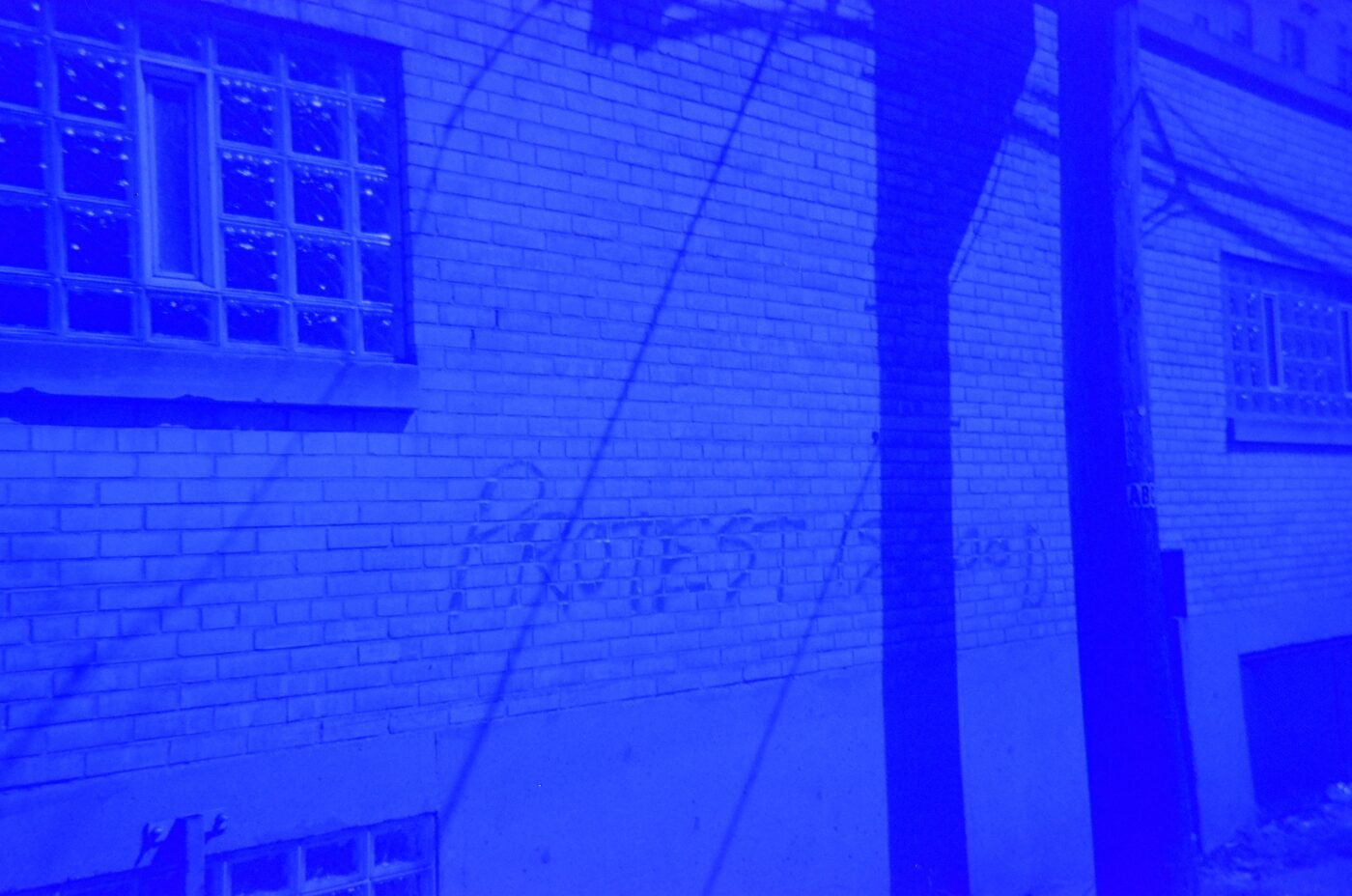
[ID: An overexposed film photograph with a blue cast depicts a brick wall in an alleyway. Graffiti on the wall is partially obscured by the shadow of telephone lines so that the remaining letters seem to spell out “protest soon.”]
Allie: Thinking about this word “expansive” that you just used, I’m curious if there was a visual or a space that you had in mind when you were crafting this track, or if there’s one that comes to mind when you listen now.
Jared: It’s so interesting because you sent me a poem [“The Universe: Original Motion Picture Soundtrack” by Tracy K. Smith] that one of your coworkers said that the piece reminded them of, which I thought was super cool, and then a friend who I collaborate with and who helped me produce the piece, Regina Martinez, said that it reminded her of the deep sea. I didn’t think about that as I was making it, but I’ve been listening back and am really in love with what I made. I do get this aquatic, unknown, large body of water feel. That’s different for me, because oftentimes people will tell me that a lot of things that I make sonically feel very airy and atmospheric. I don’t even know if that’s supposed to suggest that my temperament is changing.
I think “GIRLY*** WORLD” is supposed to be a preface to music that I’m working on and have been working on with other producers, and girly*** is the alias that I’m using: either all caps or all lowercase with three asterisks, which are always supposed to be citations. There wasn’t a visual that I had in mind, but I think some of the sounds in it, like the tuning, are quite literally the tuning of girly*** and trying to find the girly*** sound that I’m looking for and crafting.
Allie: I love this idea of finding the sound or searching for what girly*** is, and I’m curious what the breakdown is between choreography and improvisation. When you produce a track like this one, how much of it is predetermined or planned out, and how much is being navigated in real time?
Jared: I really appreciate this question. The breakdown of choreography and improvisation… I really like that. I live on the South Side in Hyde Park, and I can see all the way downtown. I can make a mental note that I’m gonna go downtown, but the way that I can see straight downtown, that’s not going to be the way that I get there, because some streets are one way, some are obstructed by the river and lake and all these different things. An artist peer and friend of mine, Shir [Ende], does a lot of work with choreography, and she said to me that architecture is like choreography for people’s bodies. I didn’t realize how much I think about sounds in a drafting kind of way, too.
For this piece, I was thinking about a draft in this cathartic way. I knew that I didn’t want the piece to start or end at the same place. I wanted it to keep opening up and maybe there’s a throughline or maybe not. The tuning is a bit of a throughline, and some of the bass that gets subdued is a throughline, but the form starts as a skeleton, and then I build on that. The improvisation comes in with how I apply samples, having this multichannel setup where all of these things are running into a mixer and I’m recording it all: I’m recording a synth and I’m recording a Roland sampler, and then I’m also doing things in Ableton. That is where the improvisation or the play comes in and things become less planned, even though I knew for this specific piece, roughly three to five minutes was what was posed to me. I knew I would pick the latter and do five because I’m so used to longer, time-based things by way of doing stuff in the club and scores and radio. It was actually a challenge to work in five minutes, but I think I needed it. I’m working on music now, and sometimes when I’m working with a producer, they want to make a three minute track and that stresses me out. I love loops, and if we find loops together I could let those play out for so long. This notion of completion or things being finished is something that I really struggle with.
This feels like a preface to actual music, because I think the girly*** music I want to make is tracks that are buried in emotion and context. I want to make songs that are sexy. I want to make songs that people want to play in their car. I want to make songs that people dance to. I want to make songs that people play when they feel like they’re that bitch or songs that people play when they feel like they’re contemplating if they’re in love with someone. I don’t know if “GIRLY*** WORLD” gives you explicitly any of those things but I feel like the possibility is there in this piece.
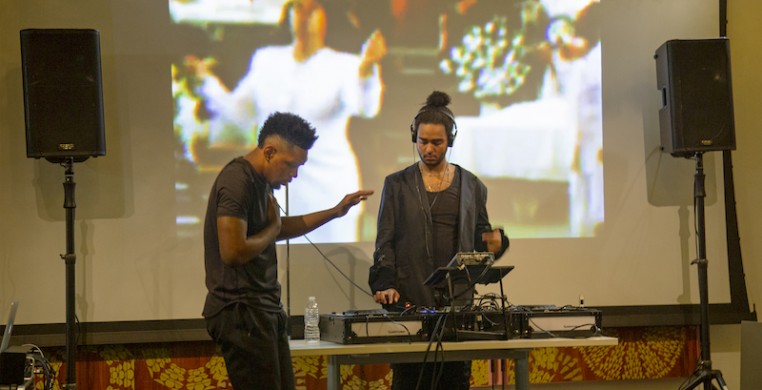
[ID: A Black male dancer wearing a black short sleeve t-shirt and black pants performs in front of Jared, who is DJing at table and wearing an unbuttoned black blazer, black tank top, headphones, and hair in a bun. Jared is looking down, focused on the gear (two Pioneer CDJs, a Roland SP-404, and mixer), and behind them is a video projection of a church scene featuring two women wearing all white.]
I want to make songs that are sexy. I want to make songs that people want to play in their car. I want to make songs that people dance to.
Allie: Yeah, that makes a lot of sense and goes back to how you started this conversation, thinking about limitations and how a limitation can be really generative. I was thinking about duration and pacing because most of the work that you’re doing is generally much longer, and you can really get lost in the full set or the radio show, so to limit yourself to only three to five minutes I’m sure can feel very different.
I was trying to put some names to it earlier, and I feel like it begins with this searching on the radio channel, and then it moves into a more atmospheric space or quietude, and then we move into a dance space or this percussive ecstasy, and then it ends on this really special moment that feels like a whisper or a secret poem, and then the tune out with the bookends of the radio at the beginning and the end.
Jared: The tuning is to highlight ties to my radio practice. It was also conceptually to play with this idea of fine-tuning girly*** as an alias and as a musical project, and finding the girly*** sound and just thinking about that physicality of it. Maybe most cars now don’t have a dial, but I just really love that feel. I’ve also been thinking about this idea of how we would share information if we were to lose the internet and about how radio at one point was that vessel. People got news and entertainment from the radio, so I wanted to insert these little bits.
These arcs, that’s what all of these things make me think about: there’s drama, and maybe a bit of a story there, and a catharsis. You start someplace and maybe you’re introduced to something, and then the story unfolds and there’s a climax, and there’s a resolution. The piece ends with this declaration of, “It’s a girly world, it’s a girly sound, it’s a girly show.” I wanted a girly*** sound to be a mantra, as clear as possible, while also manipulating it. I wanted it to be declarative, because girly***, and why I chose that alias, feel like a reclamation for me. I don’t want to get to like, my life was so traumatic or anything like that, because it’s not necessarily that, but I think when I really needed gender to work for me as a young person it just didn’t. I was misgendered for a pretty substantial amount of my life, and that creates a type of dissonance and chaos. At one point people were mistaking me to be a girl, or people would ask me, “Are you a boy or a girl?” if it was a hot summer day before I needed a glass of water. “Are you a boy or a girl?”
Choosing to identify as girly*** and girly also doesn’t feel monolithic. Ending the piece on “It’s a girly world. It’s a girly sound. It’s a girly show,” feels like a moment of justice for me and anybody that can identify with it on any level. We’re not talking about genitalia or how one presents, but that sort of catalyst for chaos in your own body and your voice doing that. People would say, “Oh, you sound like a girl,” so I just really wanted the piece to end that way in this confident space. Maybe it’s confrontational, but it’s still hopeful and playful, as well.
For me, with dancing and working within nightlife, that is what it is. Sometimes people associate the club and nightlife with drugs, but I think rhythms can create this ecstasy and rhythmic thing, and I wanted to touch on that. I had multiple versions of this piece, so I have parts where it’s almost all percussive, and I thought, that’s not what this should be for this outlet. Then I have parts where there wasn’t a percussive moment, and that didn’t feel very honest, as well. I felt like I was not accounting for a part of myself. So this version for New Suns feels like a very balanced mesh of all of these parts of what girly*** is and where I am as a sound artist. I still have qualms with “musician.” I don’t fully feel like I’ve come into my own as a musician just yet. I think I’m on the brink of it. That’s what a girly*** world is.
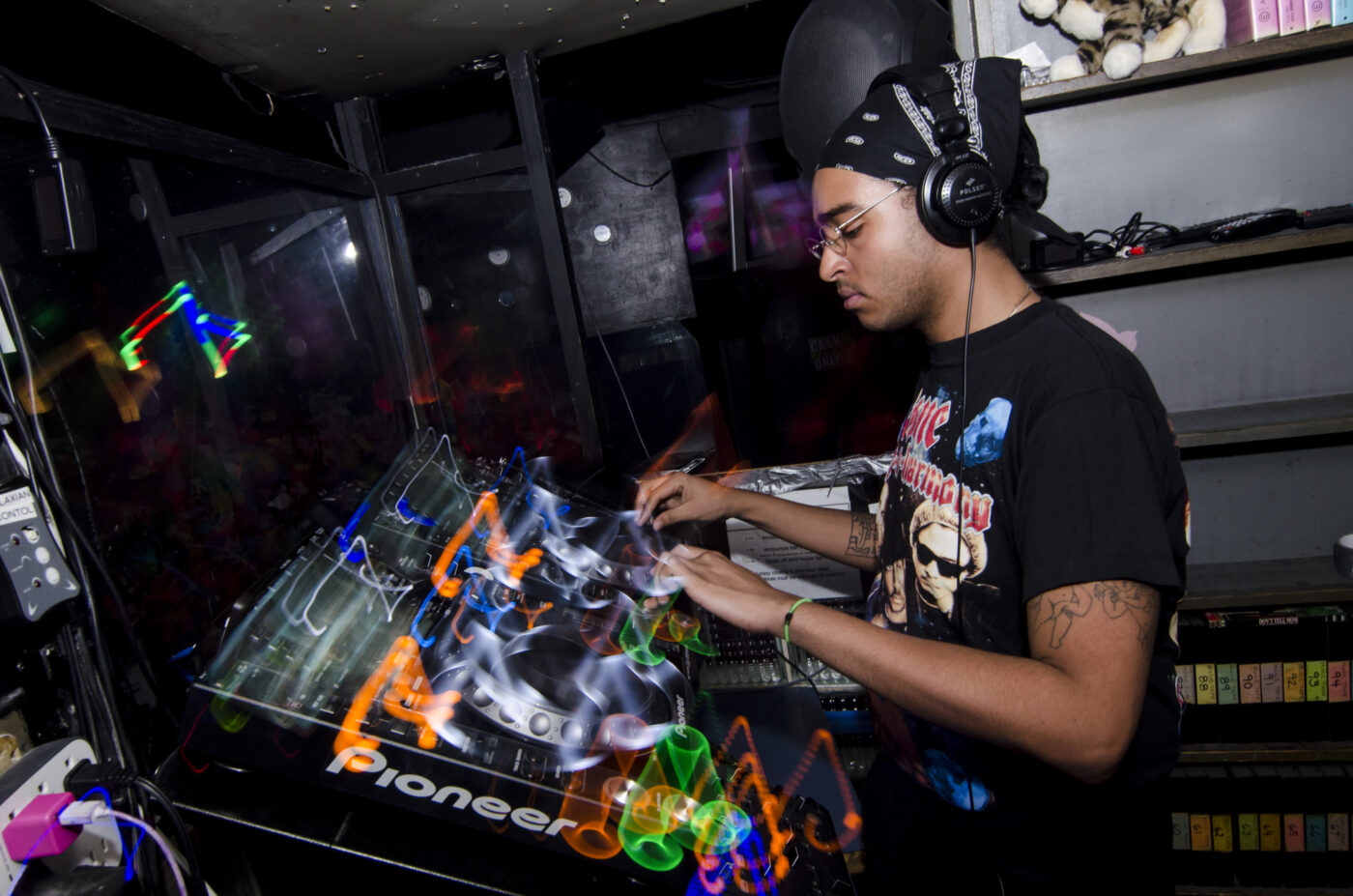
[ID: A side profile of Jared in a DJ booth mixing on two Pioneer CDJ decks. The lights from the decks are captured as orbs in the photo. Jared is focused on the decks, mixing and wearing headphones, silver eyeglasses, a black bandana, and a black Bone Thugs-N-Harmony t-shirt.]
Allie: When did the alias of girly*** begin? And as somebody who both lives in and grew up in Chicago, what is it like to be in the nightlife spaces that you’re talking about now? Do you feel like you’ve had a consistent community through the years, or has there been so much change that it feels like a different place? I’m curious to hear a little bit about your Chicago roots.
Jared: I think the weird thing about girly*** is that it was with me even when I was trying not to account for girly*** and it almost starts as a childhood wound. It was the thing that I was trying to change or alter the most because the chaos that it created when embodied through me made me so uncomfortable, because it made so many other people uncomfortable.
I had different iterations where girly*** was trying to come through and I was still trying to subdue it, because I was trying to survive and get through high school. There was a period, maybe 2018, where I just changed my Twitter handle. I would always change it, and it was kind of troll-y, but then it stuck and I started adding three asterisks to it.
I was in residence at the Hyde Park Art Center, and I was writing it everywhere, and that has ties to, again, high school. I was friends with a lot of graffiti writers. That’s even how I got into photography, because a lot of them were like, “Take pictures of my tag!” I started just having this mania where I was writing girly*** on so many things. That was 2017 or 2018, but I wasn’t public with it. It was some fantasy, or maybe I was still internally rendering it and tending to the wounded aspect of girly***, but now, I think, girly*** has transformed from being a wounded soldier to a healing agent for me, if that makes sense.
Chicago is an epicenter for music, and so many genres as we know and love them have come to Chicago and become radicalized, once coming to Chicago and then going back out. So thinking about jazz, thinking about gospel, thinking about R&B, and then obviously house music. Detroit is like our sister in a lot of ways, or like our cousin, some of us would say, which is also Midwest techno and house.
In Chicago, a lot of things didn’t feel available to me as a young person. We’re even still seeing parallels of that now where it feels like being a young person congregating in spaces is being criminalized here, so it’s harder and more complicated to get stuff off as a young person, because you need to be twenty-one and doing it in a bar, doing it in a space that’s already sanctioned, which feels really wrong and antithetical to expanding or moving or worldbuilding.
I moved away to go to Baltimore, so I never got to have my adult indoctrination here. As a teen I was going raves and what the kids now are calling “indie sleaze.” I was a teenager going to warehouse parties in Wicker Park, and that culture is no longer a thing. When I came back to Chicago as an adult, having some performance and DJing and public output under my belt, getting booked at these clubs that are historical institutions, like Smart Bar, was huge for me. Places like Berlin, which are no longer here, and having my first residency at this place called Danny’s, which closed during Covid — I only got to have one party. It felt really generative and inspiring for me, especially because I come from a family that has connections or deep relationship to nightlife. My mom used to go to The Warehouse as a teenager, and she has all these wild stories about Frankie Knuckles and not drinking the punch at The Warehouse and lying to my grandmother about where she was. So when I came back and was like, “Oh, I’m DJing at Berlin or Smart Bar,” she was like, “Oh, my God! That’s so cool! You’re DJing on a Thursday at Smart Bar, that was the night that me and my friends used to go.”
It’s full circle and really special, but it worries me now, because the city is changing so much, and Covid really forced our hand at how to reimagine what community is. It definitely forced me to really assess how much I was misconstruing community and network, or conflating the two. Chicago is also where I have learned how to be a really active, accountable community member, and I’m so thankful for that. I think the city is going through a major change right now, and I can’t quite fully put my hand on how much space communities that I occupy will have, and that’s a little scary. But I do have faith in some of the people that have been spearheading it, even before I got back to the city. They’re well organized and are willing to put everything on the line to pay people and get people to safety and housing. Even with the internet, I feel like we’re all just passing around the same $250 for mutual aid because our government right now isn’t holding us down. It’s sad, but at the same time, I’ve never been more grateful to be a part of a queer nightlife community or artist communities where people are really doing everything that they can with limitations, doing such incredible work or taking incredible initiative to do the best that they can and look out for people. Being in this country right now, specifically cities — that’s what I can speak to — it’s just hard. It’s not easy. It’s not getting any easier.
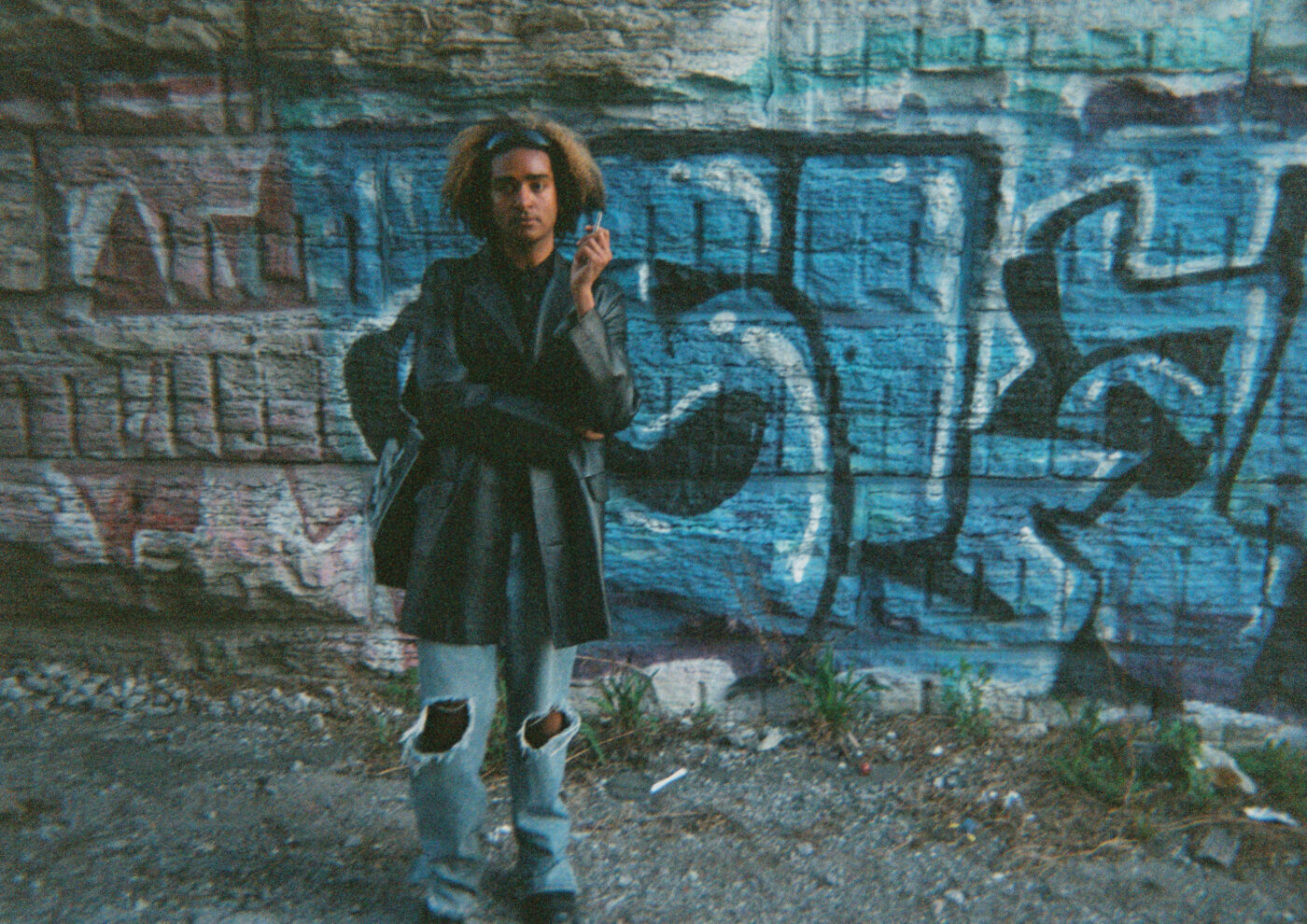
[ID: Jared stands in an alley in front of graffiti, wearing a black leather jacket, black shirt, blue jeans with holes in each knee, and sunglasses as a headband, keeping their curly hair from covering their face. They have blonde hair on top and dark hair underneath, wear a bag on one shoulder, and hold a cigarette. ]
Allie: Where are you finding inspiration these days?
Jared: I’ve been really inspired by some of my Midwestern foreparents in techno, house, or just music in general. I’m thinking about Drexciya and their way of crafting worlds with their music, and Larry Heard. I’ve been playing this Larry Heard album, Dance 2000, from 1997. All of these musicians that were making this expansive music with hand-me-down machines. It wasn’t state-of-the-art stuff. Also, A Guy Called Gerald, who is not from the Midwest. I’m drawing inspiration from all of these musicians who leaned into the limitation to make this timeless, expansive music.
I’m drawing inspiration from friends of mine, like Noa Micaela Fields’ zine In Other Words. I’ve been reading books by Toni Morrison and Assotto Saint, a poet who wrote essays and made music, a Black Queer Caribbean person using what was available to them. I’m reading this book about media that bell hooks wrote called Reel to Real. I don’t always agree with things that [hooks] writes,… I’ll read something that makes my face crack, and I’m just like, why would she say that? But then, thinking about context, she was so brave to write a review about a Quentin Tarantino film that’s being canonized by everyone and be like, actually, this is not that great, and here’s why. I’m so grateful for that. [I admire] writers — Morrison or Saint — who were naming in poetry different things that were happening in the world. Toni Morrison in each fiction quite literally builds these worlds that feel parallel to ours but are not, and us still being able to see, feel, and locate ourselves is so inspiring.
I do resort to a lot of reading when I feel scared, and I am scared right now. This past year has been a shit show for so many reasons. I’m inspired by people in my life, artist types; despite everything that is happening right now, people are still at least trying, and in trying, that’s better than not making a move at all. It’s better, I think, to fail at trying something than to not make a move at all. I’m inspired by that. I have to remind myself of that. Everyone who is still devoted to their practice despite how limited resources are for us to try to make things — I’m just inspired by those people.
Allie: Thank you so much, Jared. It’s such a pleasure to have this commission by you and to learn a little bit more about it.
Jared: Girly*** is for the girls and the girly*** folks and all power to the girlies out here that are just doing their thing and staying afloat because people really do try to sink girlies all the time in some shape or fashion, but it really is a girly*** world. All the best things are girly***.
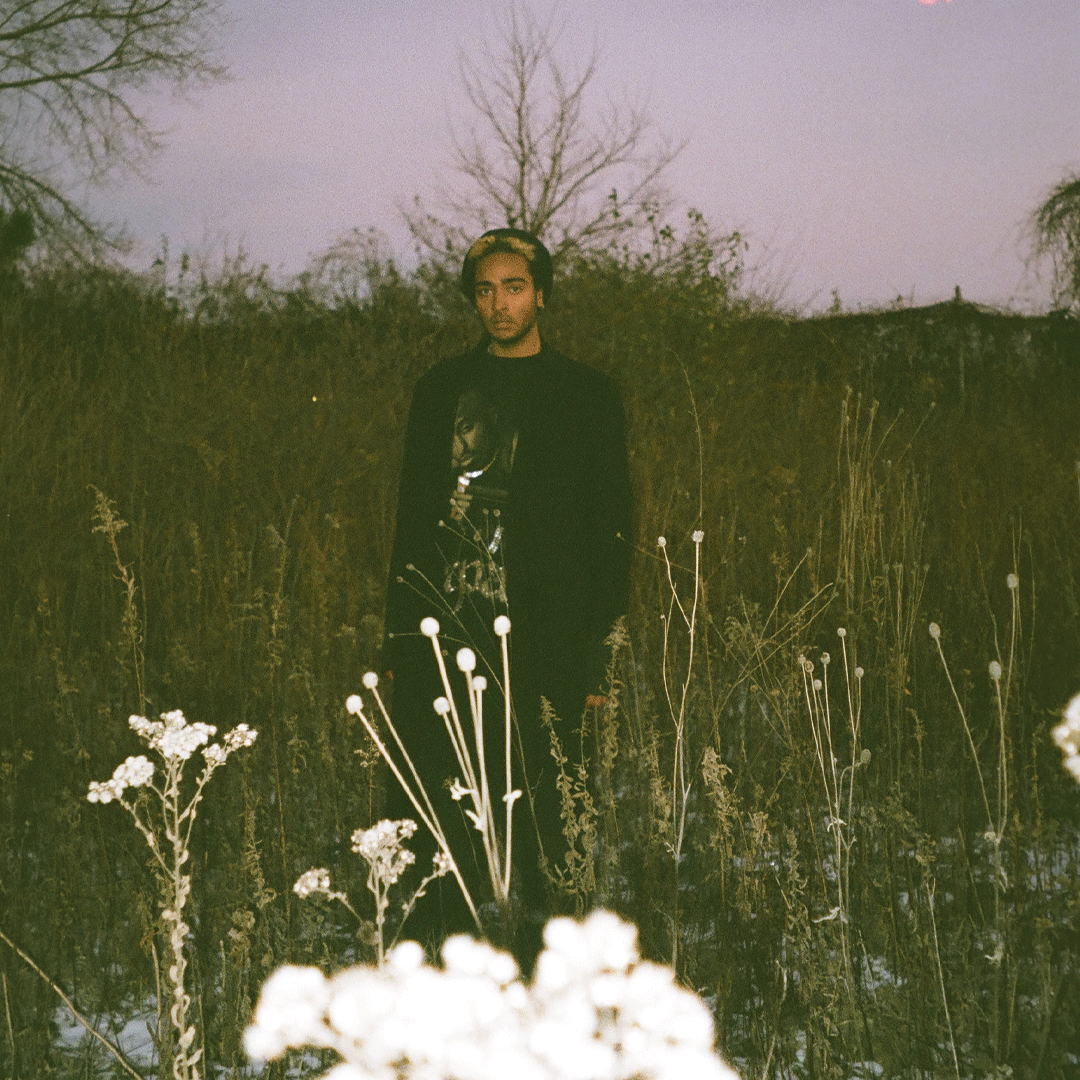
[ID: Jared stands in a vast field with tall grass in the foreground and trees and a pink sky in the background. Jared is looking at the camera and wears a black hat, black Tupac shirt, and black pants.]
Jared Brown
They // Them // Theirs
Jared
Chicago, IL
Jared Brown is an interdisciplinary artist born in Chicago. In past work, Brown broadcasted audio and text-based work through Central Air Radio 88.5 FM, in live DJ sets, and on social media. They consider themselves a data thief, understanding this role from John Akomfrah’s description of the data thief as a figure that does not belong to the past or present. As a data thief, they make archeological digs for fragments of Black American subculture, history, and technology. They repurpose these fragments in audio, performance, text, and video to investigate the relationship between history and digital immaterial space. They hold a BFA in video from the Maryland Institute College of Art and moved back to Chicago in 2016 in order to make and share work that directly relates to their personal history. They have presented work at the Museum of Contemporary Art Chicago, the Baltimore Museum of Art, the Poetry Foundation, and Elastic Arts. Brown has published work in True Laurels, The Chicago Reader, Sixty Inches from Center, Essence Magazine, and Cult Classic Magazine.
Instagram: @jsbxse
